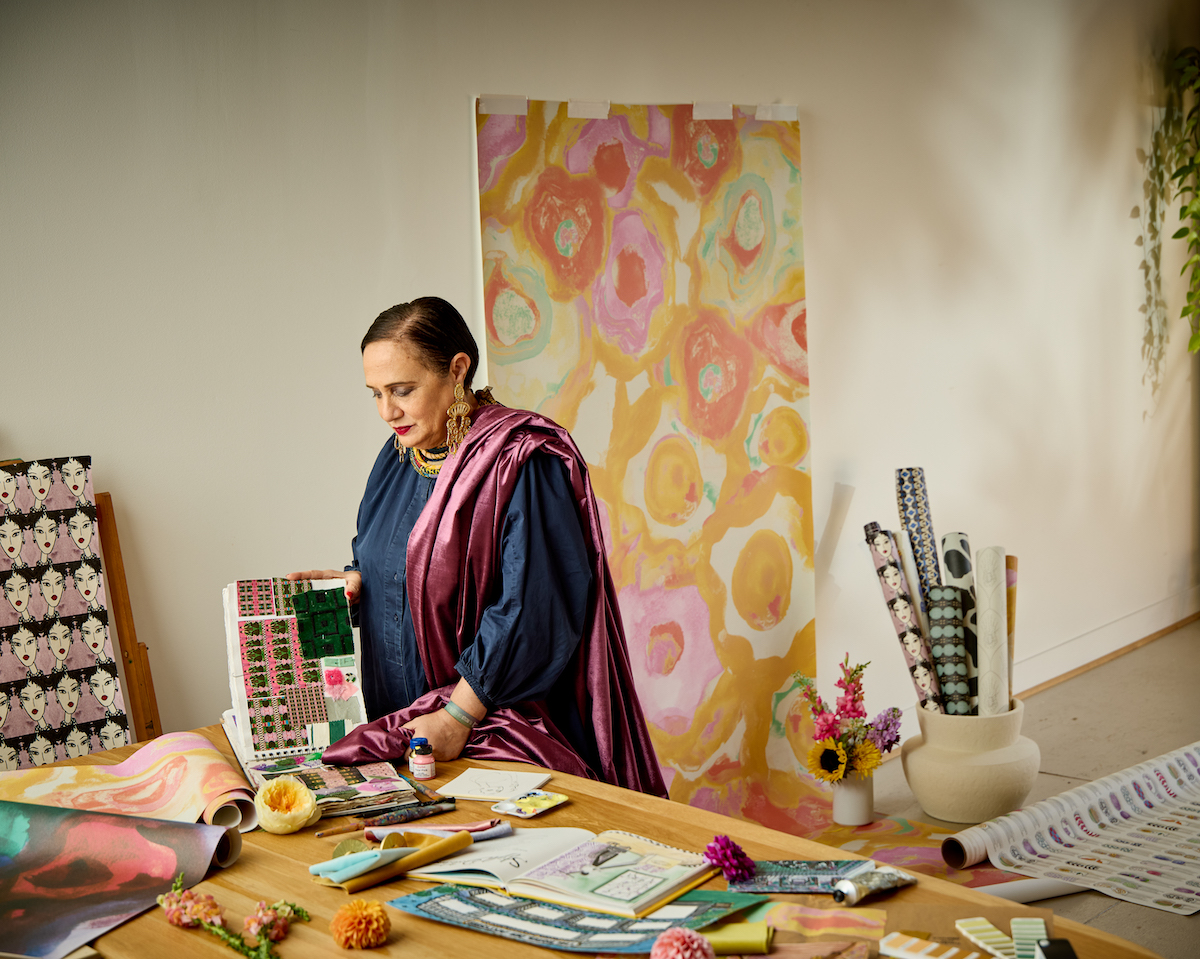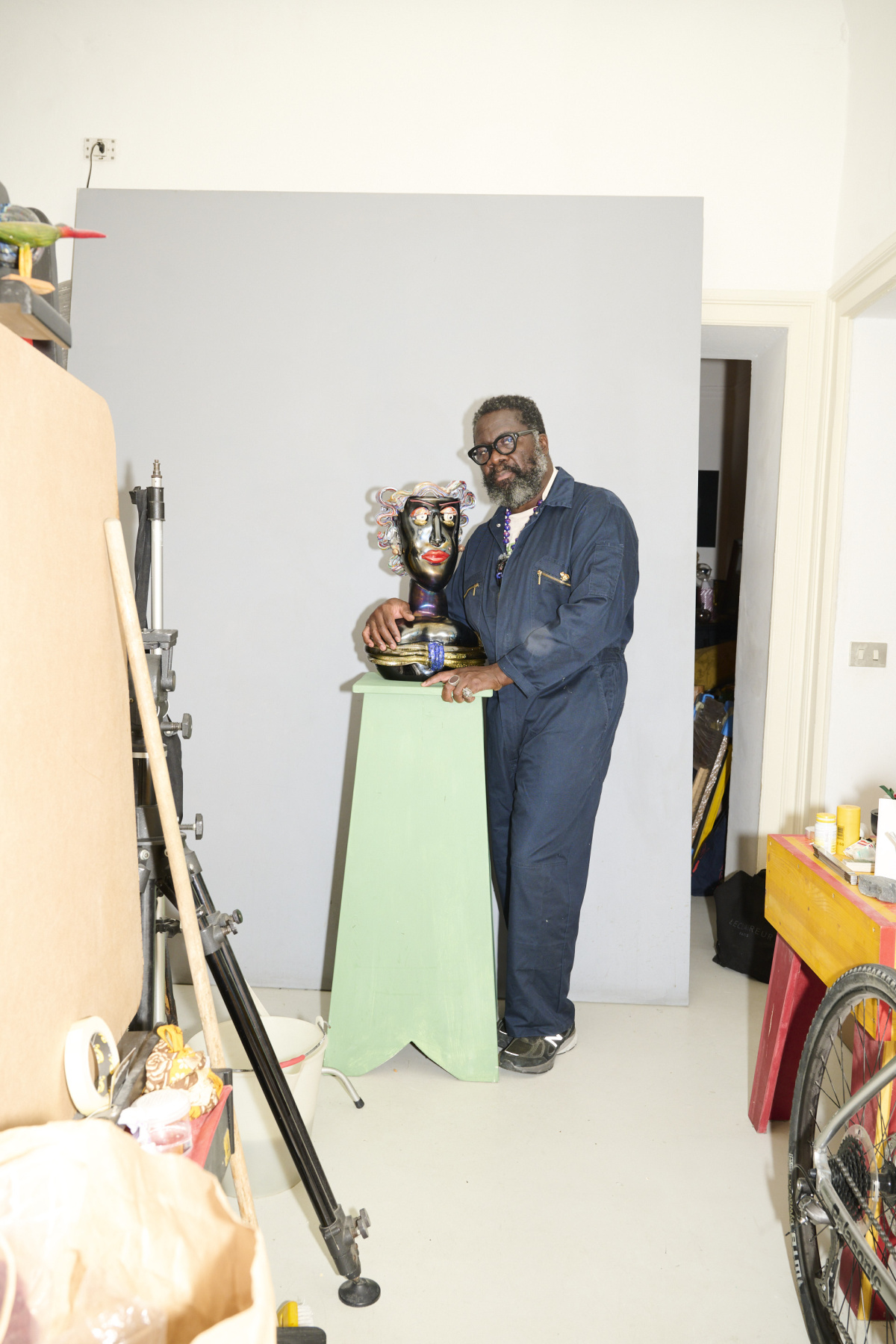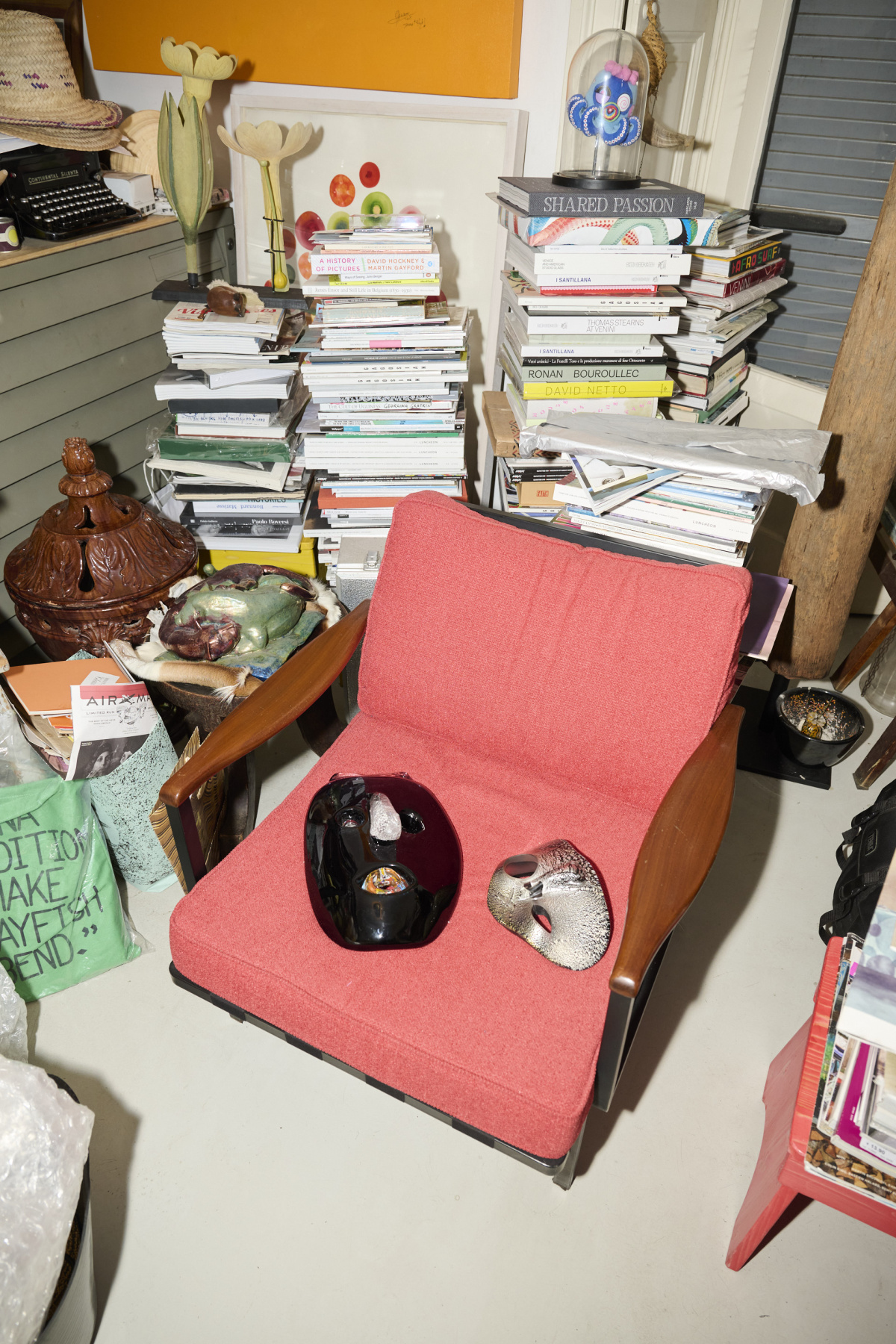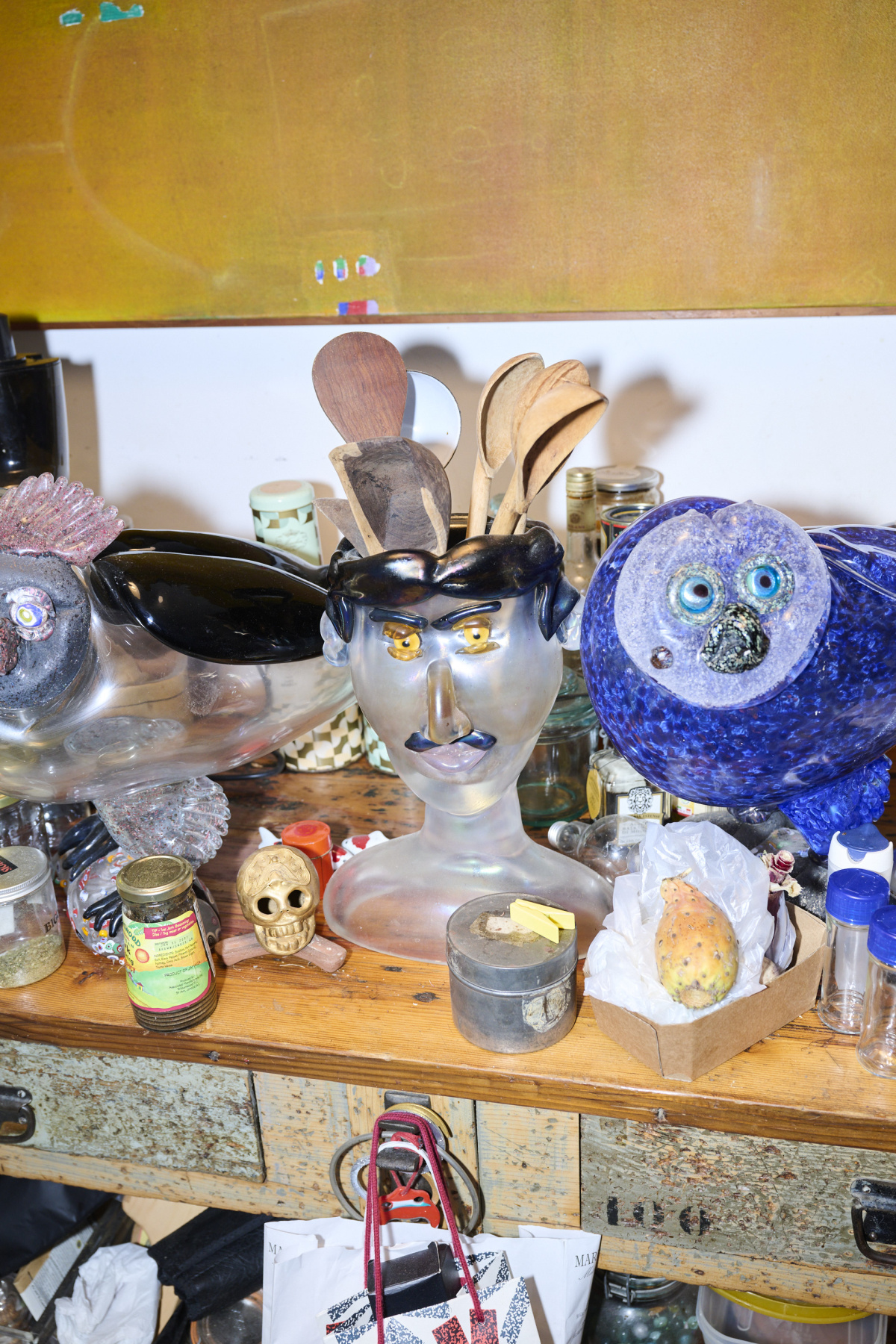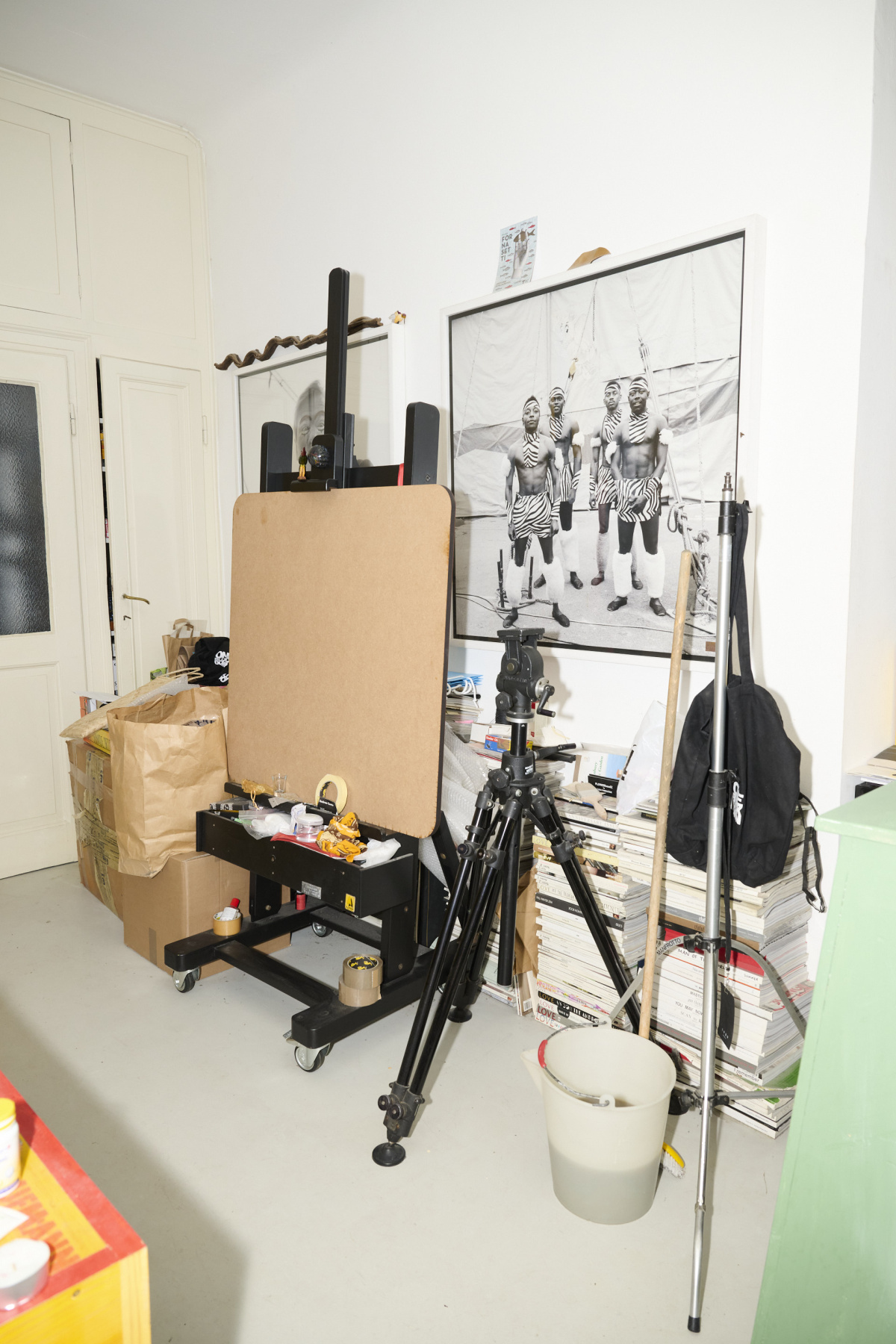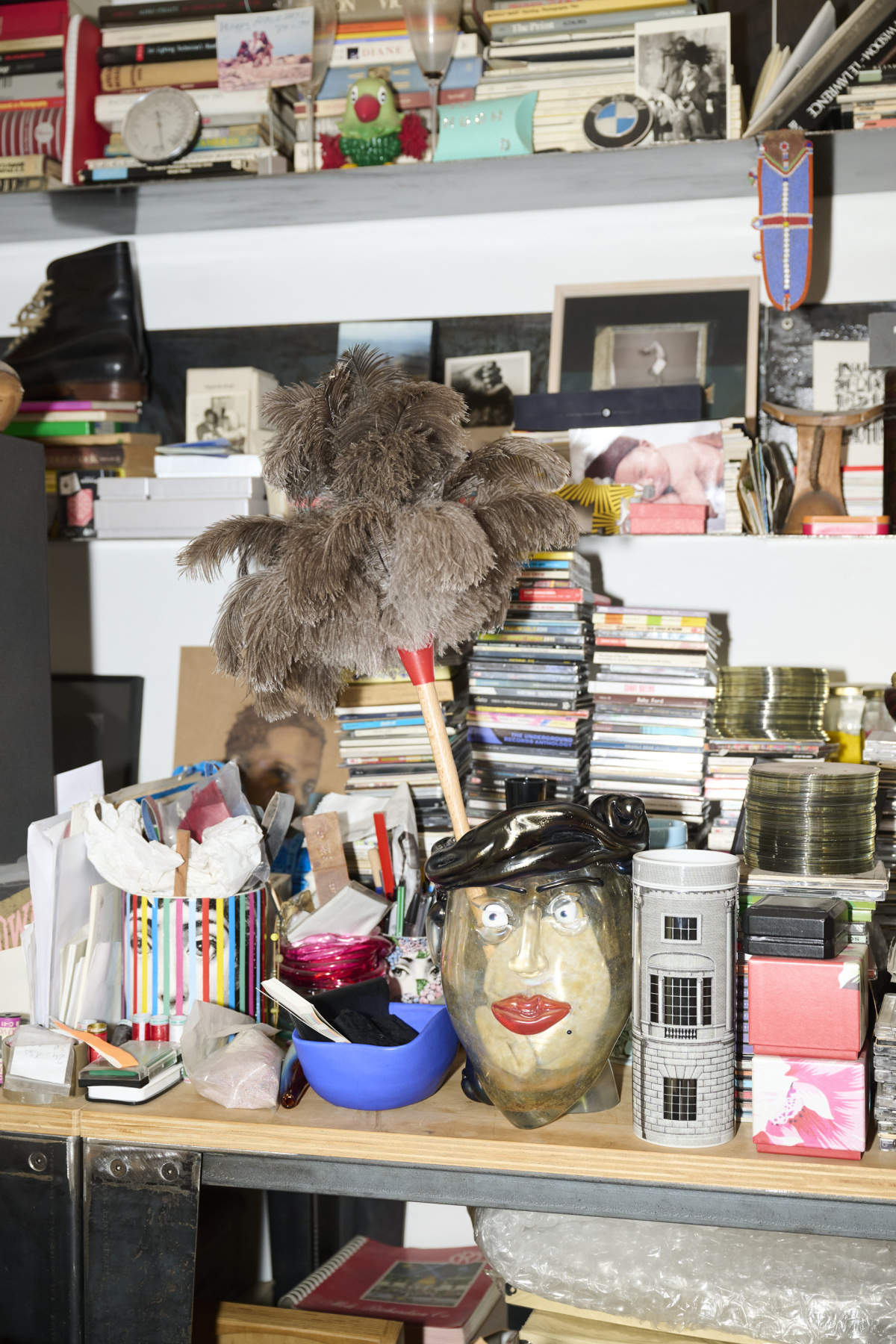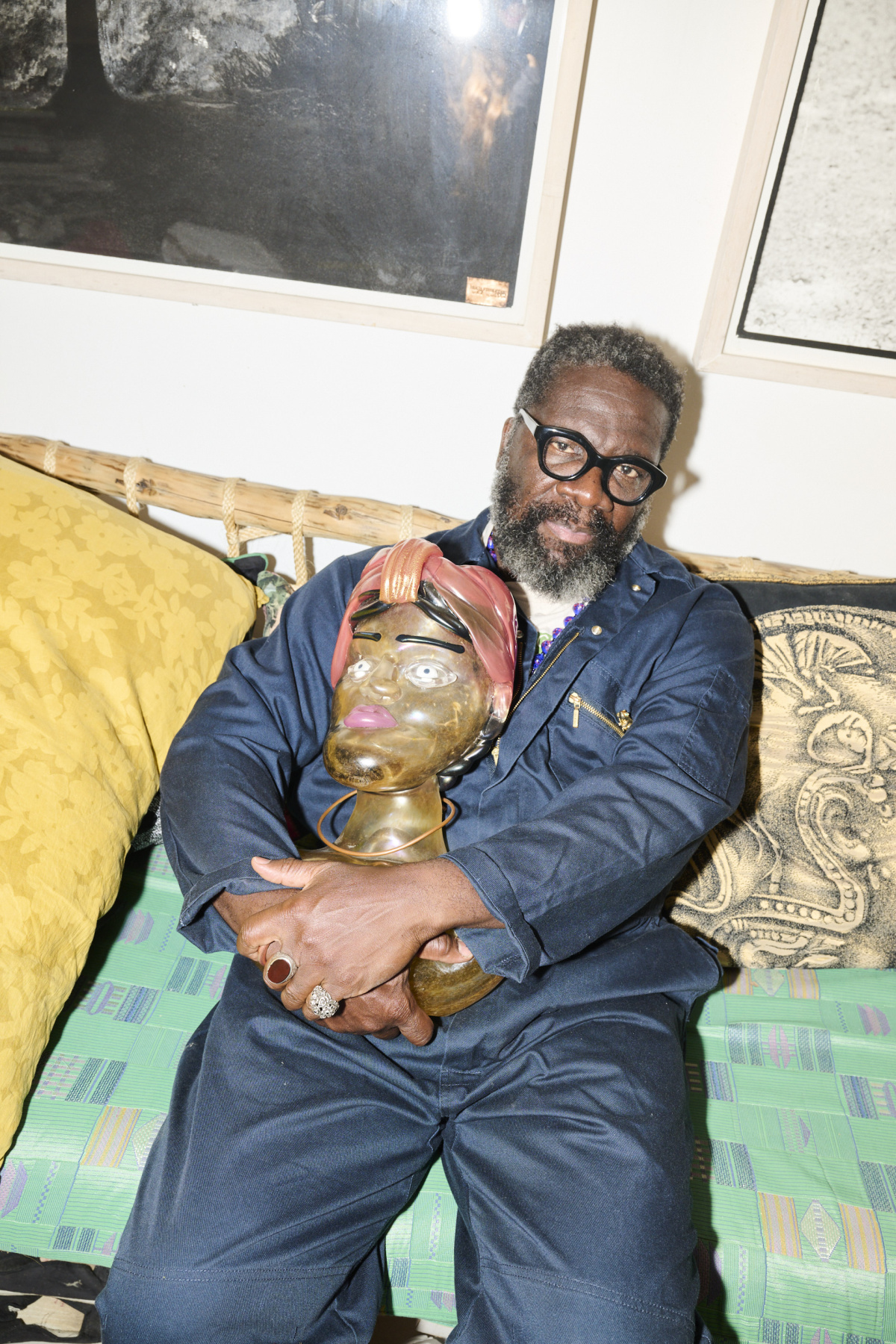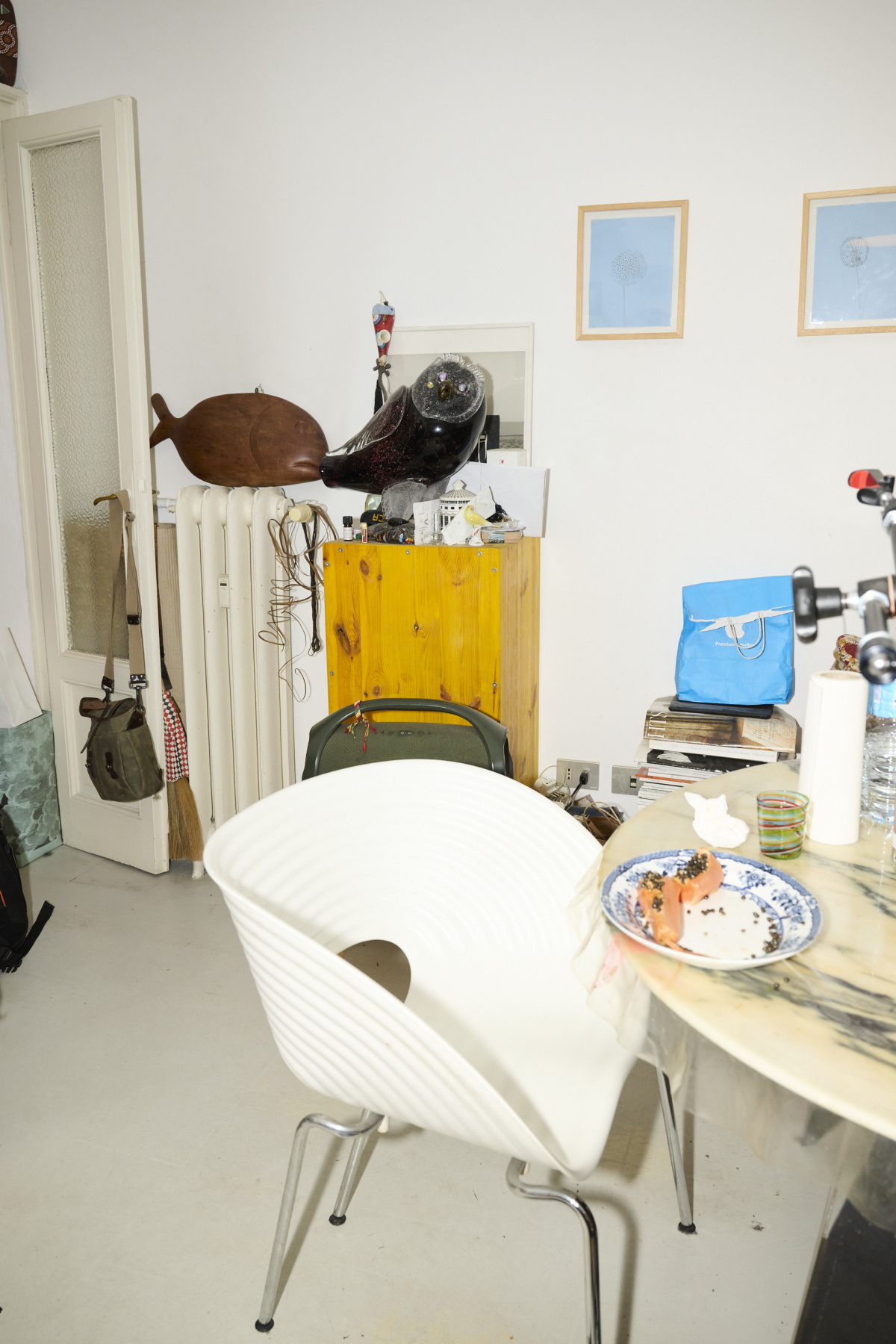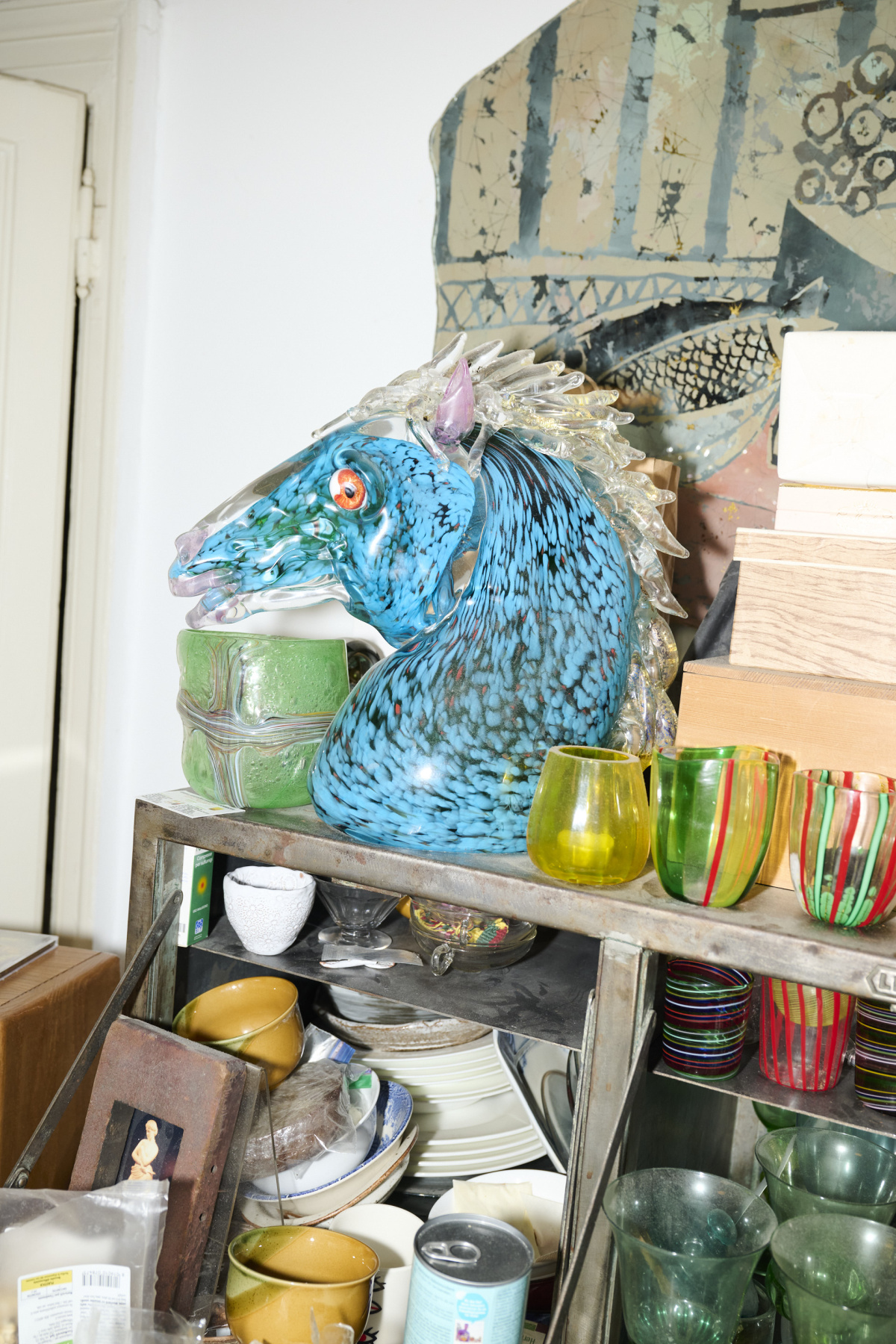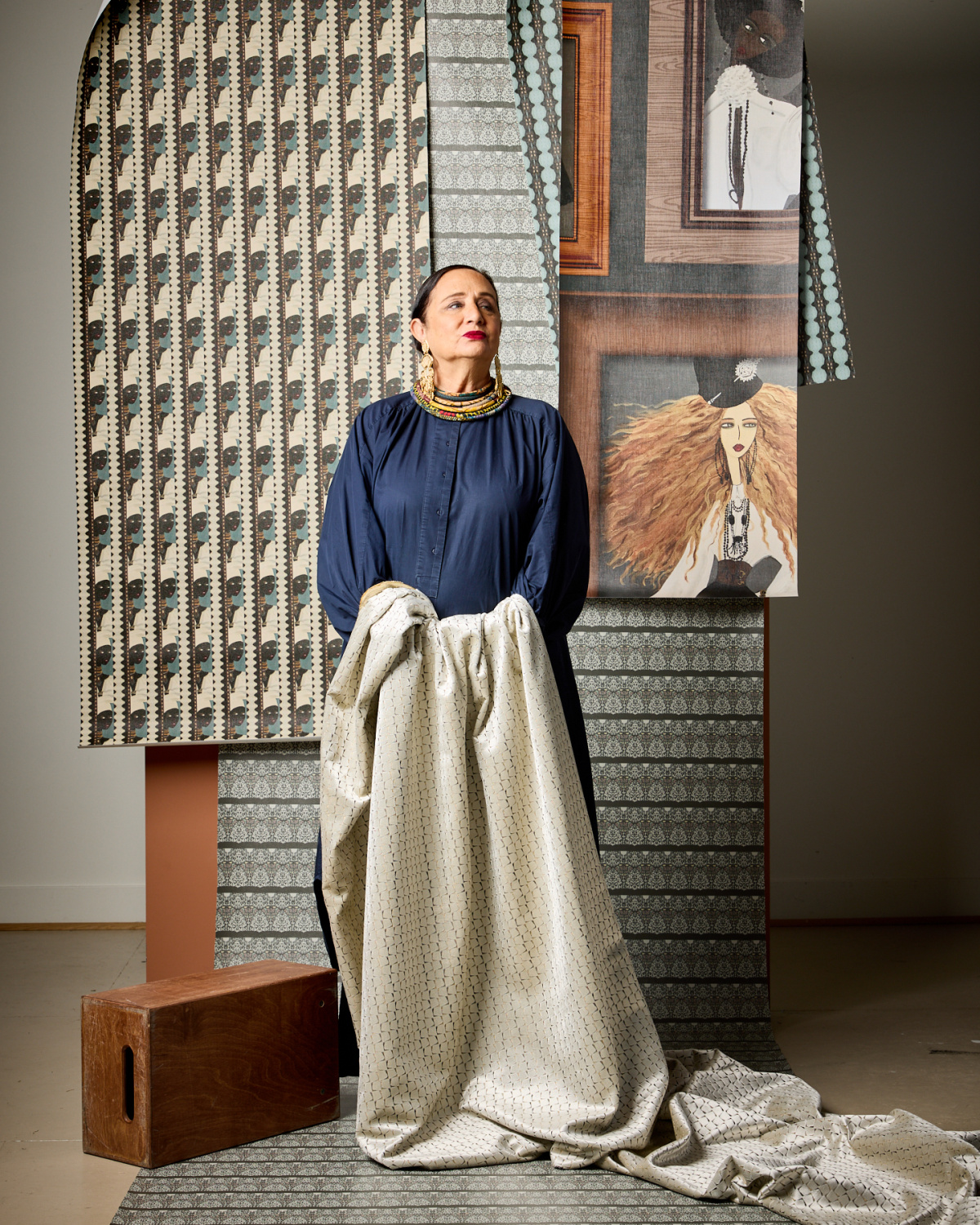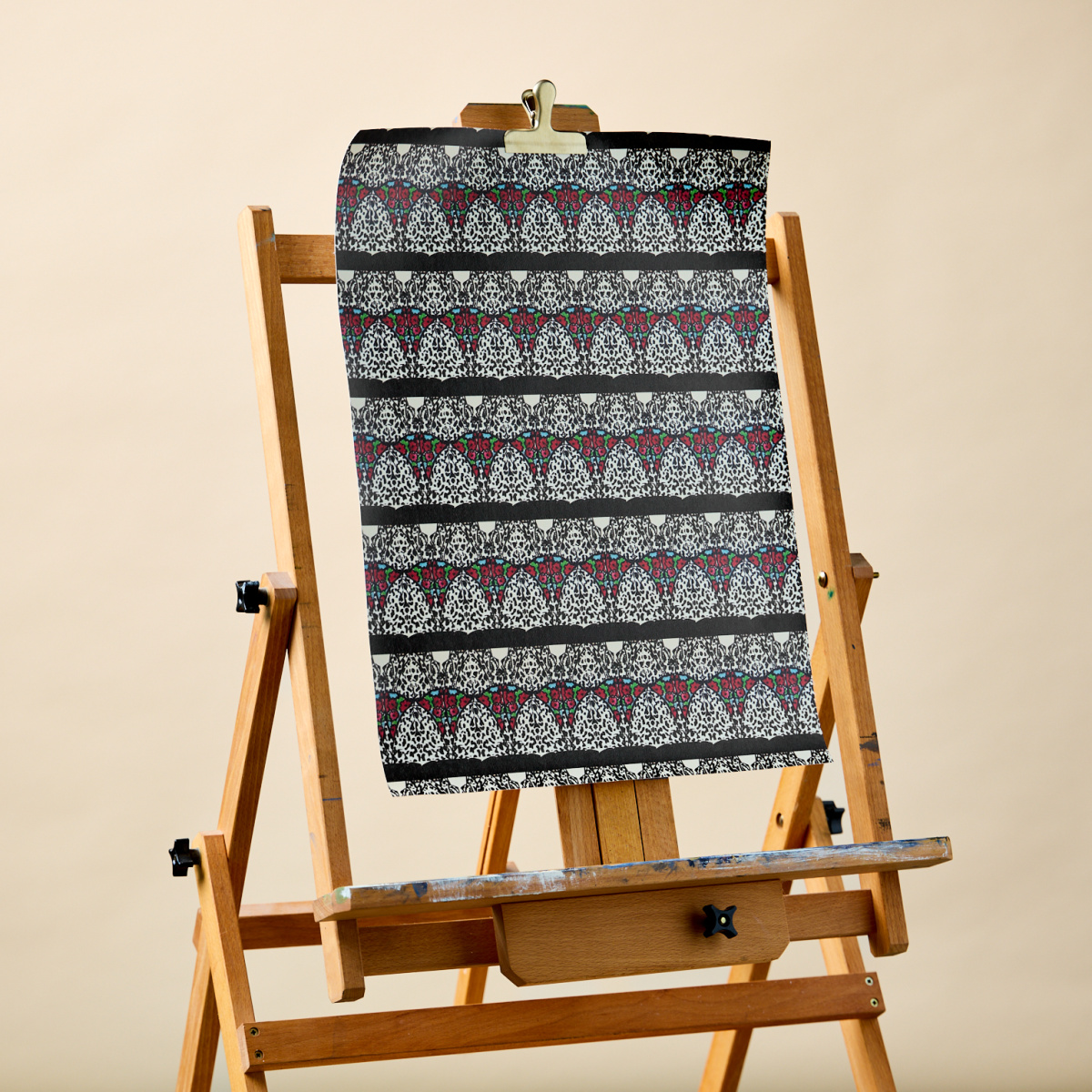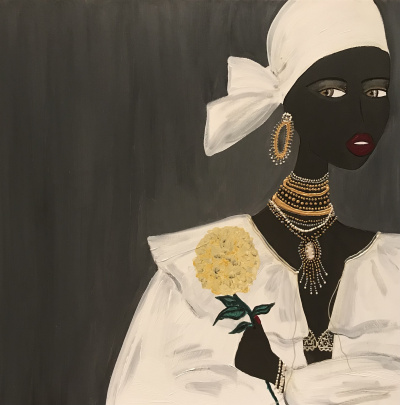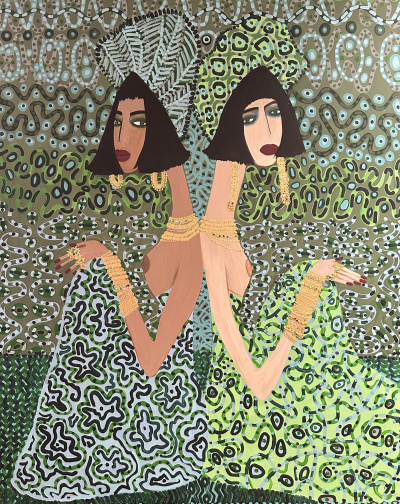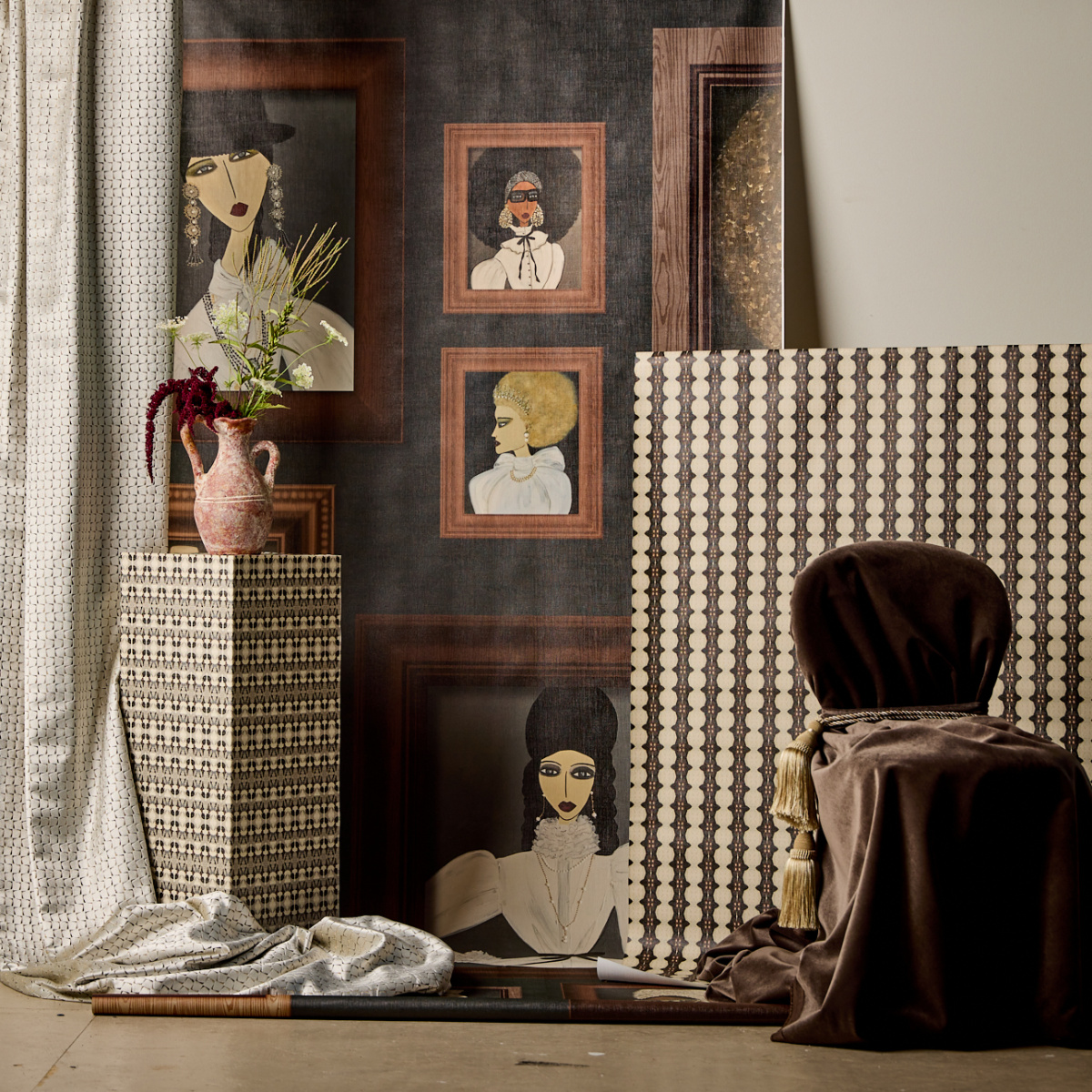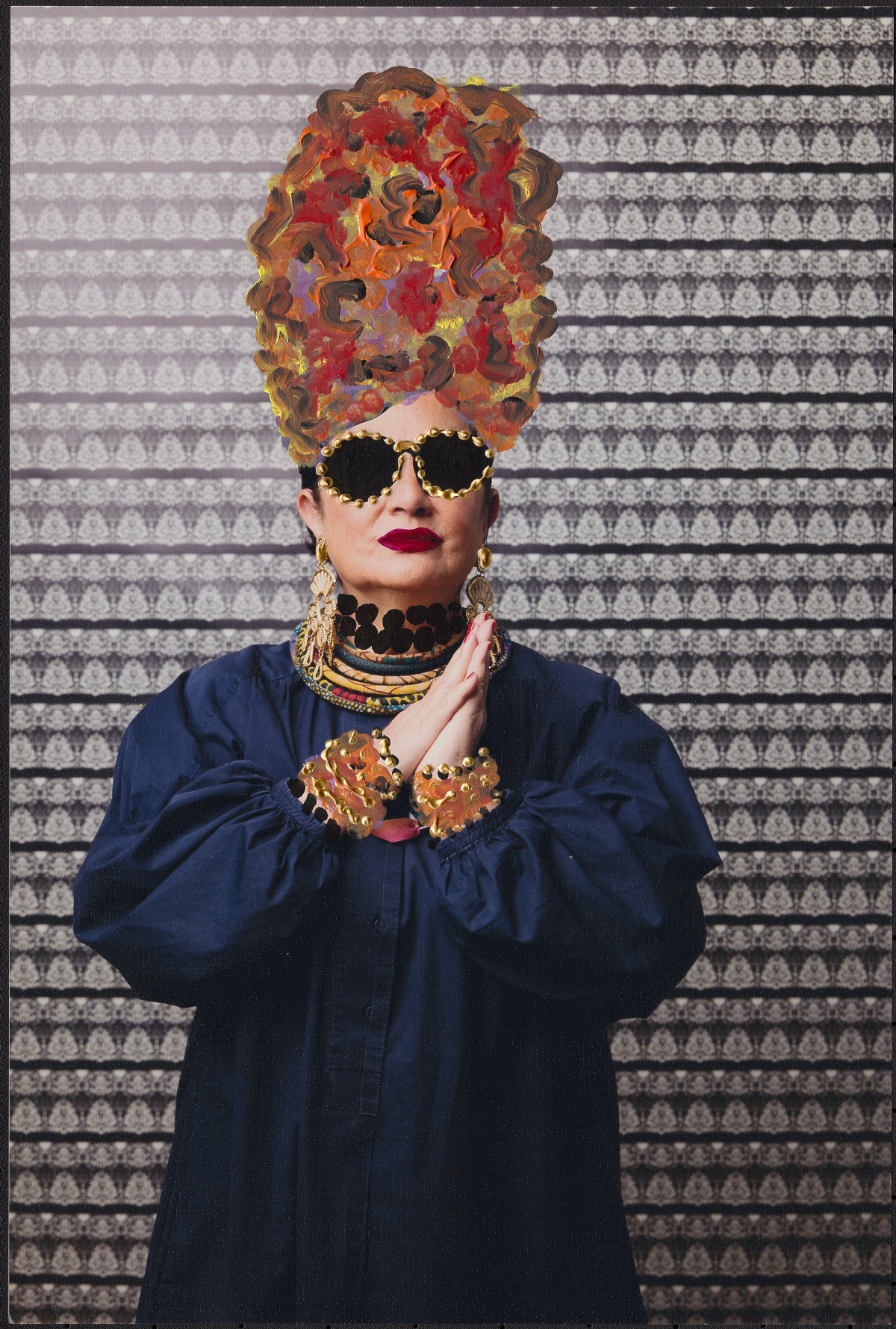What happens when two artists with a distinct lens on feminine beauty collide?
When Rebecca Moses and Hugh Findletar first crossed paths in Milan, they say it wasn’t just their art that connected them—it was a shared energy, a vibe. They instantly clicked. Rebecca, known for her contributions to the world of fashion and her bold, expressive portraits of women, says she felt an instant kinship with Hugh, whose glass-blown sculptures are filled with stories and—often—flowers.
Rebecca, a New Jersey native now living in New York, began her career in fashion working for renowned brands like Pierre Cardin and the Italian ready-to-wear house Genny. In 2005 she directed Saks Fifth Avenue’s iconic “Wild About Cashmere” initiative, where she developed 250 unique cashmere products—from jump ropes and hammocks to sweaters and loungewear. Some of her most prolific work, however, lies in the field of painting and illustration, where publications like Vogue Italy and Vogue Japan have tapped into her artistic vision. She’s also illustrated brand campaigns for Mac Cosmetics, Furla, and Fratelli Rossetti.
In her latest collaboration with Momentum Wallcoverings, Rebecca reimagines elements of her fashion-inspired art, deconstructing and transforming them into luxe wallcoverings. The collection allows designers to curate a range of moods by blending each pattern.
Jamaican-born Hugh had a childhood filled with Caribbean legends and traditions, laying the foundation for his artistic expression. His deep connection to Jamaican imagination and culture continues to influence his work, alongside a passion for horticulture passed on to him by his great-grandmother. The artist first discovered the art of glassblowing during a trip to Kenya that began a long-standing exploration into glassmaking, marrying a Western craft with the expressive force of African art. After studying in New York, Hugh eventually moved to Italy where he quickly fell in love with Murano and its glass blowers. Though today he crafts housewares and animal sculptures out of his artist studio in Milan, he is best known for his series “FLOWERheadZ,” where he reimagines the faces of women in glass—most notably Jackie Kennedy and Anne Hathaway. The series quickly gained popularity after being featured in The New York Times.
In this conversation Hugh and Rebecca discuss their upcoming projects, how women shape their artist process, and the shared realization that, at the core, they tell a similar story—just through different mediums.
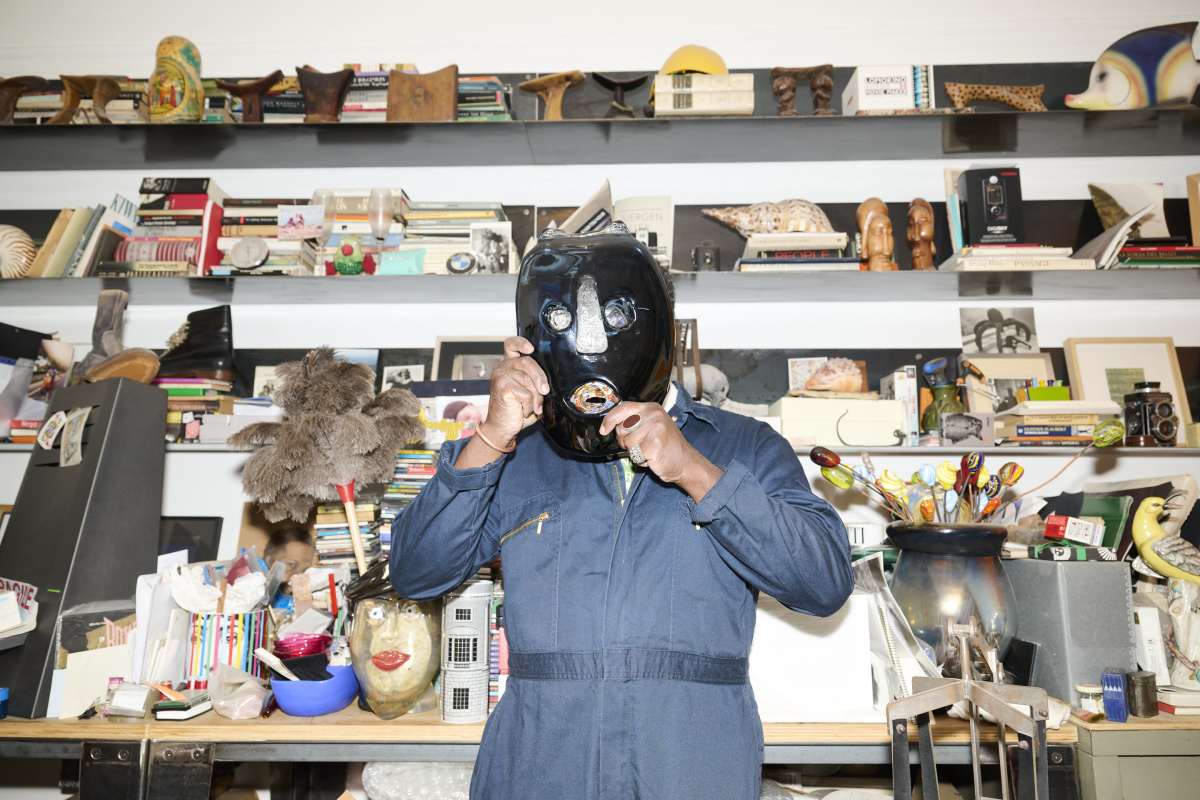
Photographed here in his Milan-based studio, artist and glass sculptor Hugh Findletar had a childhood filled with Caribbean legends and traditions. His underlying Jamaican imagination and culture further translated into his artistic works today, giving his pieces a distinct style and character. Above: One of Hugh’s many glassblown “MASKz.”
Rebecca Moses: We first met at an exhibit of mine in Milan while you were looking at my paintings, and we connected.
My art is all about women; I was raised by a very strong woman. My father was incredible, but my mom really was the one who inspired me from her role as a woman who could handle it all. Women have this incredible ability to keep 20 balls up in the air.
At the time I didn’t know your work, but you had an energy that was attractive to me. When someone has the right energy I want to bring them into my tribe. When I finally saw your work, I was like, no wonder!
Hugh Findletar: It’s so funny because I felt the same on my end. I’m pro-woman. I love with the idea of being nurtured and cared for by women. In my work, you notice that there’s more women than men. I’m attracted to the beauty of women.
When I was in Jamaica as a young boy, there were all these festivals that happen like Junkanoo, where everybody dresses up and over-exaggerates their beauty. The women would tie their head with a homemade scarf and stick flowers or plants in it. I tried to bring a lot of that into play within my work. My great grandmother also had a passion for horticulture, so I wanted to honor her through my art as well.
Eventually I thought, “Why don’t I create human figures in glass and fill their heads with thoughts and ideas?” That’s how I began creating my sculptures.
If you look at my pieces you’ll notice the nose is shaped in a very particular way. When I first looked at your work, I felt your portraits also had a distinct nose, only you were going slim and I was going curved and big. I thought to myself—there’s something going on there, and I’m in love with that!
- Though he crafts housewares and animal sculptures, Hugh is best known for his series “FLOWERheadZ,” (above) where he reimagines the faces of women in glass—most notably Jackie Kennedy and Anne Hathaway.
- “The act of putting a piece together is like giving birth,” Hugh says. “You go through the process of trying to figure out how to get the shape and color right. Everything has to be thought out.”
It’s funny you say that because the nose has always been an issue for me. You always have a crazy aunt who says something to you like, “You’d be such a pretty girl if you had a different nose.”
I grew up with that all the time, too. I went through life being told I had a big nose, but eventually I fell in love with it. Now in my artwork I try to make noses a little bit beyond their normal size. I appreciate what you’re doing through painting, because I’m basically doing the same thing with glass and three-dimension.
When I look at what you do with glass, it’s so different than what I do with a paintbrush. You’re working with heat at 1,000 degrees, dealing with stuff that can just shatter in a second, yet you’re still able to capture so much personality. That’s not easy to do with a paintbrush, let alone with melting glass.
The act of putting a piece together is like giving birth. You go through the process of trying to figure out how to get the shape and color right. Everything has to be thought out. Meanwhile while you’re working, you see it start to take shape. You have to put in a little bit more or take a little bit away.
Fire is the common denominator of the whole thing—it’s what really decides everything. I’m playing the devil’s advocate with fire, trying to trick myself into going in a certain direction to get what I want. Oftentimes it’ll work. Sometimes it explodes and I start from scratch.
- “If you look at my pieces you’ll notice the nose is shaped in a very particular way,” Hugh says. “I’m going curved and big.” Above: One of Hugh’s “FLOWERheadZ” and “PatooK” in Vero Blue.
- Hugh first discovered the art of glassblowing during a trip to Kenya that began a long-standing exploration into glassmaking, marrying a Western craft with the expressive force of African art.
How do you deal with that psychologically?
One of the first things I learned when I was working in Murano was if something breaks, forget about it. Move on and make something better.
I live with that same philosophy. When things go wrong, you have to own and express it—maybe there’s a reason it went wrong. As artists, our lives are all about our self-expression.
A while back, a potential client wanted to meet with me before she bought a piece. She flew to Venice with her daughter and fixed an appointment to come see me work. Afterward she was convinced, so she went back home and placed an order.
She wanted a very specific piece. At first, I kept on trying to crank that piece out, and it wasn’t coming. I had to give it four tries—two broke, and the other two survived. She ended up loving it. The energy that went into it was incredible, and it was exciting to be able to satisfy her.
- After studying in New York, Hugh moved to Italy where he quickly fell in love with Murano and its glass blowers.
- “One of the first things I learned when I was working in Murano was if something breaks, forget about it,” Hugh says. “Move on and make something better.”
It’s overwhelming to meet clients sometimes. I meet them often because I do many commissions.
Last year I got a royal commission for a very important queen. I was asked to paint her and her daughters. When I started, I had no problem painting the daughters—but when it got to the queen something wasn’t clicking. I was being challenged because I found her personality so impressive. It almost overwhelmed me thinking about how to capture her.
The first painting I did of her she didn’t relate to. I was like, “Shit.” I always tell people when I do commissions, “This is me seeing you. This is not you seeing you. What I paint is how I see you.” I think I made her larger-than-life in personality in the first interpretation, and she was too uninhibited. I had to revisit and really harness the control, the dignity, and the regality to figure out how to communicate that. Eventually I got it, and she loved it—but it was intimidating.
- A deep connection to Jamaican imagination and culture continues to influence Hugh’s work, alongside a passion for horticulture passed on to him by his great-grandmother. Above: “PatOOk Crazy.”
- “I’m working with a softer palette right now—lots of powder pink, baby green, soft yellow. I’ve been smoking some of my glass pieces too, so they take on this iridescent finish.” Above: “HorseHEAD.”
I also had a show in New York a few months ago called “Bohemian Gardens.” It was my first exploration into partial nudity. I was asking myself how I, as a woman, wanted to express a “reveal.” It was very challenging. I did so many paintings I didn’t like. I’ve always dressed and stylized women, but “taking it off” was more challenging for me. I eventually realized the sexiest thing a woman has is her energy.
That’s so true. When women have an energy that’s beyond normal—that’s the sexiest thing.
It’s interesting. I thought to myself, “What is it that arouses somebody?” You never know. Approaching these paintings was very unique for me. The eyes were as important as her nipples.
Funny enough, I can relate to this. I had this client from Beirut who told me she wanted her glass figure “to be sexy.”
Before I make a piece I create the eyes first. I consider how wide away from the nose bridge I want them to be, or how much I should push them back into the socket. They have an identity in my head. Their DNA is to keep them like a family, but still each one has their little story going on.
For her piece, I decided to rotate the eyes just a little bit to the side so they weren’t staring at you. Instead I made the two nipples stand in for the eyes.
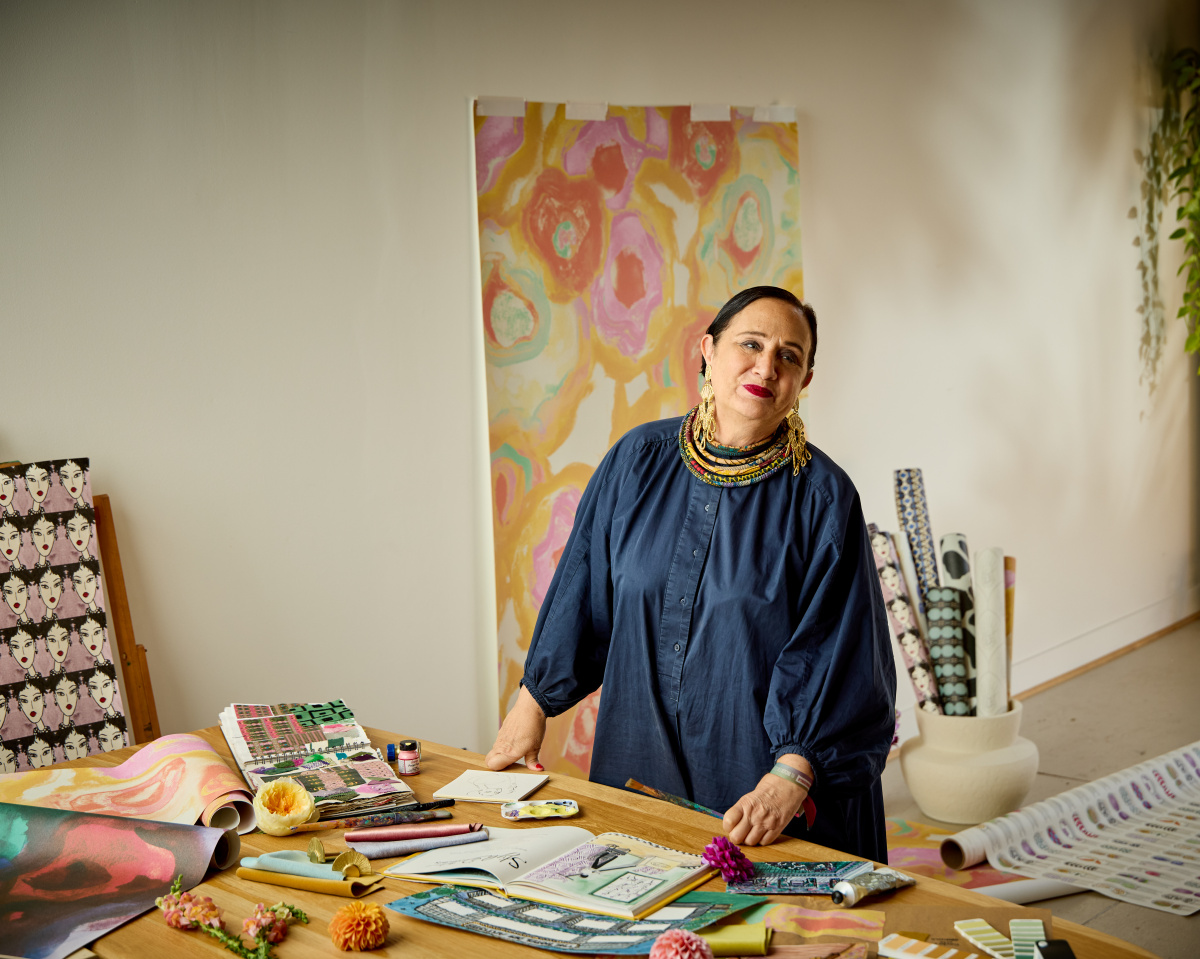
In her latest collaboration with Momentum Wallcoverings, Rebecca Moses reimagines elements of her fashion-inspired art, deconstructing and transforming them into luxe wallcoverings. The collection allows designers to curate a range of moods by blending each pattern. Photo courtesy Momentum
That’s amazing. As a designer, I’ve always been captivated by how women want to express themselves. I’ve been working on a wallcoverings collection with Momentum that stems from that. The collection branches off of my painting called “The Queen” from my “White Shirt” series.
Each wallcovering reimagines “The Queen” in various creative ways, making her almost unrecognizable—when you look at the wallpaper, you’re not quite sure who or what you’re seeing. They aren’t your typical aristocratic, blueblood wallcoverings. Every print in the collection is built around this woman. For instance, the Art Deco pattern in one of the designs is actually an abstraction of her, drawn from the jewelry she wears.
Looking at this collection, having just come back from Africa, I saw some similar works by the Yoruba people from Nigeria. They work with beads and patterning just like this. From a distance it looks like a painting—but when you go up close, you can see someone sewed those beads in there.
- Each wallcovering reconstructs Rebecca’s paintings in creative ways, making them almost unrecognizable. “When you look at the wallpaper, you’re not quite sure who or what you’re seeing. They aren’t your typical aristocratic, blueblood wallcoverings,” she says. Wallcoverings from left: Reflection, Kimono Mosaic, Portrait Gallery, and Queen’s Dots. Photo courtesy of Momentum
- “When you look at this collection from 20 feet away, you don’t see what you see when you get up close,” Rebecca says. “It’s all an illusion.” Above: Kimono Mosaic. Photos courtesy Momentum
That’s the visual I wanted! The collection is geared toward the hospitality industry because I’m a big lover of wallpaper prints right now. I just love finding new, unexpected ways to mix and layer them. I think that nowadays hotels, instead of just being lifestyle hotels, have to become hotels of a lifestyle.
I also married into a very traditional family. My mother-in-law taught me so much about old world style, and I just fell in love with wallpaper. When Momentum came into my life I was like, “Wow, this is so exciting.”
It was just such good timing, too, because I love color. Color is my pulse. I know it’s your pulse, too. It’s my go-to starting point—but I look at these wallcoverings as the “new colors.” They’re multi-dimensional. They’re not about one shade. When you look at them from 20 feet away, you don’t see what you see when you get up close. It’s all an illusion.
It’s a beautiful collection. What’s even more beautiful is the magic that comes from when you get close to entering the head of the creator. It’s a ticket to wanting to know more.
The next time you’re in Italy, you need to go to Bisazza and do a glass mosaic based on your wallcoverings.
- “The Queen,” a central figure of artistic inspiration in Rebecca’s collaboration with Momentum, was also part of her “White Shirts” exhibition. The Queen is confident in her design choices and who she is. She wears a simple white shirt, but her accessories allow her to make her own mark.
- “The ‘Bohemian Gardens’ exhibition was my first exploration into partial nudity. I was asking myself how I, as a woman, wanted to express a ‘reveal.’” Above, “Jade and Acqua” acrylic on canvas. Photos courtesy Rebecca Moses
I’m dying to do a mosaic! I’m madly in love with tiles—they’re such a fascinating surface. In fact in this launch, I created an imaginary hotel called Hotel des Artistes, inspired entirely by art. I even designed an indoor cabana, because not every hotel is set in a tropical resort. I took the floral wallcovering I created and transformed it into tiles for the pool. It feels like a beautiful fusion of all my work. I’m truly so excited about it.
I totally understand that anticipation. I have an exhibition that just opened up at Bergdorf Goodman gallery in New York City, and I can’t wait to show you the new pieces. I get chills just thinking about it. I’m working with a softer palette right now—lots of powder pink, baby green, soft yellow. I’ve been smoking some of my glass pieces too, so they take on this iridescent finish.
I also created two vases sculpted as heads, which I called FLOWERHeadZ, for Homo Faber. The first one is called “Miss Wendy” based on a schoolmate of mine. I added freckles to this piece that are made from glitter so if you put a spotlight on her, she glows. Her hair is this rainbow story of colors as well
The other one, called “Miss Parris,” is based on a woman who lives in Washington, DC. She’s been supporting my work for the last couple of years so I thought, “Let me make a piece without her even having to even think about buying it.” It’s just there for the show, and it’s done.
I’m experimenting night and day trying to figure out the next move. People will often try to copy what I do, so I used to keep my projects a secret. Now after getting a New York Times cover story, people can’t even go down that road.
- Work from Rebecca’s “White Shirts” exhibition paired alongside her wallcoverings collection. The series conjures up images of aristocratic women, having been seen as an emblem of wealth, class, moral responsibility, and uniformity. She uses the white shirt as the ultimate equalizer. Wallcoverings from right: Queen’s Montage, Portrait Gallery, Queen’s Dots.
- “The collection came at such a good time, because I love color. Color is my pulse. It’s my go-to starting point. I look at these wallcoverings as the ‘new colors.'” Above: Kimono Mosaic. Photos courtesy Momentum
But you know something? You can’t copy the soul of work. Coming from the world of fashion, where people are copied constantly, and going into art—I guess it’s the highest form of flattery.
You and I are probably a lot alike in that what we do is a constantly evolving method. I don’t have enough hours in the day. Every day you have to grow, experiment, and push. You just have to keep moving forward in your practice.
It’s true. My work actually started out not with creating glass heads, but glass fish. I created them to decorate my home. Then two weeks ago I went to this antique dealer in Kenya, and he had some beyond colorful fish sculptures made by the Bozo people in Mali. I didn’t know about them when I made my fish, but I felt a connection to them.
It was crazy—all the work I saw from the Bozo people is exactly what I imagined before making my fish collection. So I get you—the idea of always experimenting and taking things to the next level is just the call of the day. I’m always thinking about the next twist and turn to make a piece better.
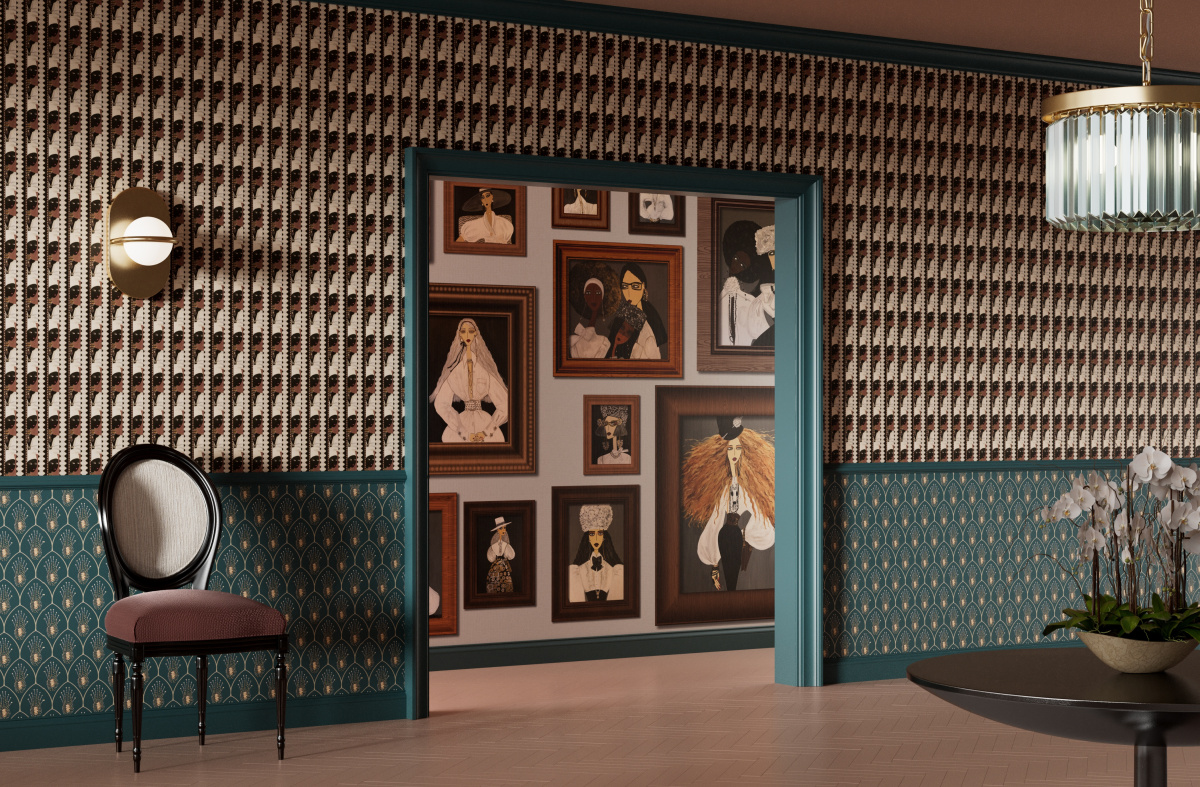
“My mother-in-law taught me so much about old world style, and I just fell in love with wallpaper. When Momentum came into my life I was like, ‘Wow, this is so exciting.'” Above: Reflection, Deco Dreams, and Portrait Gallery wallcoverings.
This is the life of creatives! What else are you working on right now?
I’m also developing a perfume at the moment. The scent is done, and the bottle is almost ready. My work centers around the garden. Within that garden you have the people, the animals, the fruits, the vegetables—and then of course, the scent.
I’ve incorporated a lot of notes from my childhood into this perfume, like the memory of women in Jamaica mixing vetiver with rose oil when we went to church. It’s so vivid in my mind. I’m trying to put that into a package for women, or for anyone who loves those scents. Everyone who’s tried the tester is freaking out—they want it now!
Do you have anything else lined up?
The wallpaper with Momentum is really the newest thing for me at the moment. I’m also really pumped up about the upcoming election in America.
During COVID, I painted over 440 portraits of women from around the world documenting what everyone was going through. It was called the “Stay Home Sisters,” and it just came together so organically. I was sitting in New York City and thought, “I’m going to lose my mind if I don’t use my art to heal or help others.”
I decided to ask women to send me notes on social media about what they were going through, and I painted their portraits to document it. It became a global project, and the sisterhood that emerged was remarkable. These women started connecting with each other and supporting one another. I was literally painting every single day, from morning to night. I even painted 40 nurses in New York City—they were hit the hardest. With the election coming up, this year I created the “Go-Go Vote Girls” because I felt we had to act. I’m asking women to send me notes again, this time about why this election matters to them. I’ve been receiving letters from everywhere.
I’m obsessive about it—I’ve put everything else aside for this project.
I love that. There will always be special women who guide us in a certain direction or keep us in a certain mood. I’m constantly highlighting them, too. When I’m not making commissioned pieces I try to highlight girlfriends, family members—people who are part of my life.
In time, as a story, they become a part of my story. We live out the story together.
momentumtextilesandwalls.com, rebeccamoses.com, instagram.com/mr.flowerheadz
